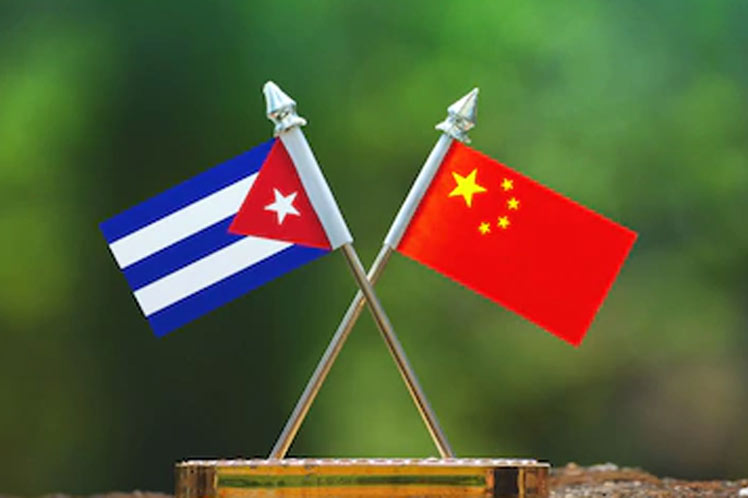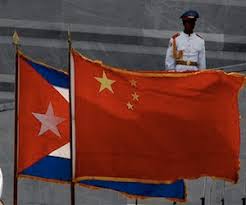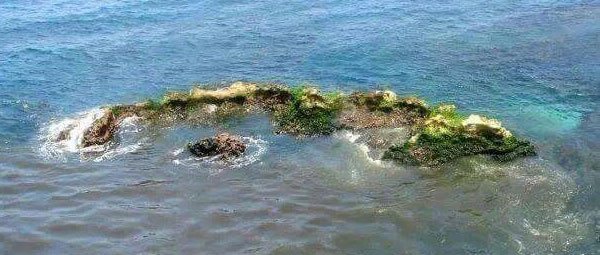 RELACIONES EXTERIORES: CUBA Y CHINA. SU FUTURO, UNA EXPECTATIVA.
RELACIONES EXTERIORES: CUBA Y CHINA. SU FUTURO, UNA EXPECTATIVA.
Cuba es el primer país latinoamericano que estableció relaciones diplomáticas con China (28 de septiembre de 1960) y es el único país comunista de América Latina. Además, China es el segundo socio comercial más importante de Cuba. Cuba apoya activamente a China en cuestiones de principio en los asuntos internacionales, como las cuestiones críticas de derechos humanos, Taiwán, Tibet. También coinciden con oponerse a la injerencia extranjera en los asuntos internos, observar la Carta de las Naciones Unidas y apoyar la reforma de la ONU.
Desde la perspectiva de la cooperación económica y comercial, China ha brindado mucho apoyo al desarrollo económico cubano. Al principio, la relación comercial incluía protocolos comerciales a largo plazo, intercambio de productos básicos y firma de un protocolo comercial anual. China importa azúcar, cítricos, mineral de níquel y cobalto y productos farmacéuticos de Cuba, y exporta a Cuba equipos mecánicos y eléctricos, cereales, aceites y alimentos, equipos y repuestos automotrices, equipos médicos, productos de la industria ligera y prendas de vestir. La cooperación bilateral en el futuro se centrará en la agricultura y la industria petrolera. La compañía petrolera nacional cubana CUPET declaró recientemente que Cuba podría tener reservas recuperables de 20 mil millones de barriles de petróleo en el Golfo de México. SINOPEC, la petrolera estatal china, firmó un acuerdo con CUPET en La Habana el 25 de noviembre de 2008 para desarrollar los recursos petroleros. Este es uno de los frutos importantes de las visitas del ex presidente Hu Jintao a Cuba. Ambas partes anunciaron que cooperarán en el desarrollo de petróleo y gas, ingeniería, servicios técnicos y comercio de equipos petroleros. China ha rescatado a Cuba con préstamos de miles de millones de dólares y, como resultado, tiene acceso a gran parte de su petróleo en el Golfo de México.
RELACIONES DE CHINA CON CUBA Y AMÉRICA LATINA.
China tiene relaciones comerciales con casi todos los países latinoamericanos, pero el 90 por ciento del comercio se concentra en Brasil, Argentina, Chile, México y Perú. China ha visto aumentar su comercio con América Latina de $ 13 mil millones en 2000 a más de $ 100 mil millones en 2007, convirtiéndose China en el tercer socio comercial más grande de América Latina. Aunque el comercio total con Cuba es pequeño en comparación con el comercio chino con Brasil, Chile y otros países latinoamericanos, se espera que crezca rápidamente.
En la actualidad, China es el segundo socio comercial más grande de Cuba después de Venezuela, y el comercio bilateral representa el 12 por ciento del comercio exterior total de Cuba. Cuba es el mayor socio comercial de China en la región del Caribe. El comercio bilateral ha aumentado de menos de $ 0,8 mil millones en 2004 a más de $ 2,2 mil millones en 2008. Además, China ha iniciado una amplia cooperación económica con Cuba. Los chinos habían invertido en 13 proyectos en Cuba a fines de 2006 en áreas como agricultura, turismo, telecomunicaciones, industria ligera, etc. China ya ha invertido directamente más de $ 70 millones en Cuba, mientras que Cuba ha invertido en algunos proyectos de turismo. y medicamentos biotecnológicos en Beijing y Shanghai. Cuba también ha establecido hospitales oftálmicos en Qinghai y Henan.
El comercio bilateral entre China y Cuba en 2005 ascendió a 777 millones de dólares, de los cuales 560 millones fueron exportaciones chinas a Cuba. El comercio bilateral entre China y Cuba en 2014 ascendió a 1.600 millones de dólares. China está enviando una cantidad creciente de bienes duraderos a Cuba. Los productos chinos se han convertido en las herramientas principales tanto en la revitalización planificada de la infraestructura de transporte cubana como en la “Revolución Energética” de 2006 para proporcionar electricidad a la población cubana. Algunas transacciones a gran escala incluyen:
Transporte
A mediados de 2006, Cuba había comprado 100 locomotoras a China por 130 millones de dólares. A principios de 2006, Cuba había firmado un contrato por 1.000 autobuses chinos para transporte urbano e interprovincial.
Refrigeradores
El gobierno cubano está reemplazando los electrodomésticos más antiguos por modelos más nuevos y de mayor eficiencia energética, incluidos 30.000 refrigeradores chinos.
Níquel
En 2004, China había acordado planear invertir 500 millones de dólares en la finalización y operación de Las Camariocas, una planta de procesamiento sin terminar de la era soviética. Según el acuerdo, Cubaníquel, el productor estatal de níquel, posee el 51 por ciento y Minmetals Corporation, propiedad del gobierno chino, posee el 49 por ciento. El financiamiento para el proyecto proviene del Banco de Desarrollo de China, y Sinosure, la Corporación de Seguros de Crédito y Exportación de China, brinda garantías.
Petróleo
SINOPEC, la petrolera estatal china, tiene un acuerdo con la estatal CUPET (Cuba Petroleum) para desarrollar recursos petroleros. A mediados de 2008, SINOPEC había realizado algunas pruebas sísmicas de los recursos petroleros en la isla de Cuba, pero no había perforaciones. La compañía también tiene un contrato para la producción conjunta en una de las áreas costa afuera de Cuba de alto rendimiento potencial, frente a la costa de Pinar del Río, pero no había realizado perforaciones costa afuera a mediados de 2008. En noviembre de 2005, PetroChina Great Wall Drilling Co., Ltd. y CUPET celebraron una ceremonia para la firma
EL FUTURO DE LA RELACIÓN ENTRE CUBA Y CHINA.
La mayoría de los países latinoamericanos se han mantenido alejados del modelo cubano, siendo Venezuela la excepción. Pero este es un problema en sí mismo porque Cuba tiene pocos amigos en el mundo. La gente puede preguntarse, dada la distancia geográfica, la débil economía de Cuba y la pérdida de Cuba de su carta de juego entre la Unión Soviética y China después del colapso de la Unión Soviética, ¿por qué China invirtió millones de dólares en Cuba en los últimos años?
China ha dado la impresión al mundo entero de que tiene en alta estima la relación entre los dos países. Los líderes chinos han visitado Cuba más veces que cualquier otro país latinoamericano. Pensar que la necesidad china de recursos naturales impulsa la relación de los dos países es incorrecto. Honestamente hablando, Cuba es una isla empobrecida con menos recursos naturales que otros países latinoamericanos. El comercio entre los países a menudo se cita como más de $ 2.5 mil millones, una cantidad muy pequeña para una potencia económica como China.
La mayoría de las veces, este apoyo mutuo se expresa mediante una cooperación económica y comercial más estrecha entre los dos países. Al mismo tiempo, el desarrollo de las relaciones económicas y comerciales de los países se basará en el principio de reciprocidad y regulación del mercado. Aunque Cuba y China están dirigidos por partidos comunistas, tienen una diferencia aparente en lo que es el socialismo y cómo construir el socialismo. También tienen diferencias en el modelo de desarrollo y la conceptualización del desarrollo.
En particular, han seguido modelos económicos muy diferentes, con China adoptando la economía de mercado mientras que Cuba todavía tiene un sistema de mando con la mayor parte de la economía bajo control estatal.
En la actualidad, Venezuela es el mayor socio comercial de Cuba. Debido a la condición cambiante de Venezuela, Cuba debe poner más énfasis en la cooperación con China. Cuba busca involucrar a China en esquemas de integración con otros países latinoamericanos (como el “Plan Alternativo Bolivariano” de Venezuela). Pero esta posibilidad no es muy probable. Por supuesto, China, sin duda, dará apoyo político a Cuba y viceversa. Después de todo, ya han caminado uno al lado del otro durante los 60 años desde que Cuba y la República Popular China establecieron relaciones diplomáticas formales el 28 de septiembre de 1960.
Cuba fue uno de los 53 países que en junio de 2020 respaldó la ley de seguridad nacional de Hong Kong en las Naciones Unidas.
Actualmente, la política diplomática china hacia Cuba mantiene el principio de amistad equilibrada y se centra en la cooperación económica y comercial. La cooperación económica entre los dos países debe ser la más importante y el área clave de cooperación, siendo el azúcar y el níquel las principales importaciones chinas de Cuba. El anuncio de Cuba del descubrimiento de grandes recursos petroleros puede ampliar la cooperación entre los dos países.
Con la toma de la presidencia por parte de Raúl Castro de su hermano, Cuba entró en un período de ajuste de sus políticas y posible reconsideración del camino chino, seguido por el nuevo presidente más joven Díaz-Canel. Cuba está ahora muy interesada en la reforma china. Este sería un buen punto de confluencia para construir una relación positiva entre Cuba y China. Sin embargo, Raúl es un líder anciano y aún tiene el control de la dirección política cubana y el futuro de la situación política cubana aún no está claro. Cuba y Venezuela, los países de izquierda más radicales de América Latina, proporcionarán las más altas pruebas del arte y la estrategia diplomáticos chinos en América Latina.
En mi opinión, la política exterior china hacia Cuba seguirá un camino de amistad moderada. Tal vez como dice un famoso dicho chino, “una buena cerca mantiene la amistad verde”.
 FOREIGH AFFAIRS: CUBA AND CHINA RELATIONS. ITS FUTURE, A CHINESE PERSPECTIVE.
FOREIGH AFFAIRS: CUBA AND CHINA RELATIONS. ITS FUTURE, A CHINESE PERSPECTIVE.
Cuba is the first Latin American country that established diplomatic relations with China (September 28, 1960) and is the only communist country in Latin America. Furthermore, China is Cuba’s second-largest trading partner. Cuba actively supports China on issues of principle in international affairs, such as the critical issues of human rights, Taiwan, Tibet. They also coincide with opposing foreign interference in internal affairs, observing the Charter of the United Nations, and supporting the reform of the UN.
From the economic and trade cooperative perspective, China has given much support to Cuban economic development. In the beginning, the trade relationship involved long-term trade protocols, exchanging commodities, and signing an annual trade protocol. China imports sugar, citrus, nickel and cobalt ore, and pharmaceutical products from Cuba, and exports mechanical and electrical equipment, cereals, oils and foodstuffs, automotive equipment and parts, medical equipment, light industry products, and garments to Cuba. Bilateral cooperation in the future will be focused on agriculture and the oil industry. Cuba’s national oil company CUPET recently declared that Cuba may have recoverable reserves of 20 billion barrels of oil in the Gulf of Mexico. SINOPEC, the Chinese state oil company, signed an agreement with CUPET in Havana on November 25, 2008, to develop oil resources. This is one of the important fruits of former President Hu Jintao’s visits to Cuba. Both sides announced will cooperate in oil and gas development, engineering, technical services, and trade of petroleum equipment. China has bailed-out Cuba with loans of billions of dollars, and as a result, has access to much of its oil in the Gulf of Mexico.
CHINA RELATIONS WITH CUBA AND LATIN AMERICA.
China has trade relations with almost all Latin American countries, but 90 percent of trade concentrates in Brazil, Argentina, Chile, Mexico, and Peru. China has seen its trade with Latin America climb from $13 billion in 2000 to more than $100 billion in 2007, with China turning into Latin America’s third-largest trading partner. Although the total trade with Cuba is small compared with Chinese trade with Brazil, Chile, and other Latin American countries, it is expected to grow quickly.
At present, China is Cuba’s second-largest trade partner after Venezuela, with bilateral trade accounting for 12 percent of Cuba’s total foreign trade. Cuba is China’s largest trading partner in the Caribbean region. Bilateral trade has increased from less than $0.8 billion in 2004 to more than $2.2 billion in 2008. Moreover, China has launched extensive economic cooperation with Cuba. The Chinese had invested in 13 projects in Cuba by the end of 2006 in areas such as agriculture, tourism, telecommunications, light industry, etc. China has already directly invested more than $70 million in Cuba, while Cuba has invested in some projects on tourism and biotechnology medications in Beijing and Shanghai. Cuba has also established ophthalmic hospitals in Qinghai and Henan.
Bilateral trade between China and Cuba in 2005 totaled US$777 million, of which US$560 million were Chinese exports to Cuba. Bilateral trade between China and Cuba in 2014 totaled US$1.6 billion. China is sending a growing amount of durable goods to Cuba. Chinese goods have become the primary tools both in the planned revitalization of Cuban transport infrastructure and in the “Energy Revolution” of 2006 to provide electricity to the Cuban population. Some large-scale transactions include:
Transportation
As of mid-2006, Cuba had purchased 100 locomotives from China for US$130 million. As of early 2006, Cuba had signed a contract for 1,000 Chinese buses for urban and inter-provincial transportation.
Refrigerators
The Cuban government is replacing older appliances with newer, more energy-efficient models, including 30,000 Chinese refrigerators.
Nickel
As of 2004, China had agreed to plan to invest US$500 million in the completion and operation of Las Camariocas, an unfinished processing facility from the Soviet era. Under the agreement, Cubaníquel, the state-run nickel producer, owns 51 percent and Chinese-government owned Minmetals Corporation owns 49 percent. Financing for the project is from the China Development Bank, with Sinosure, the Chinese Export, and Credit Insurance Corporation, providing guarantees.
Oil
SINOPEC, the Chinese state oil company, has an agreement with state-owned CUPET (Cuba Petroleum) to develop oil resources. As of mid-2008, SINOPEC had done some seismic testing for oil resources on the island of Cuba, but no drilling. The company also has a contract for joint production in one of Cuba’s offshore areas of high potential yield, off the coast of Pinar del Río, but had done no off-shore drilling as of mid-2008. In November 2005, PetroChina Great Wall Drilling Co., Ltd. and CUPET held a ceremony for the signing of two drilling service contracts, to provide drilling rigs for oil exploration on Cuba’s north coast.
Biotechnology
In December 2005, the two countries signed an agreement to develop biotech joint ventures within the next three to five years. Two manufacturing plants using Cuban technology and processes were operating in China as of early 2006.
THE FUTURE OF THE RELATIONSHIP BETWEEN CUBA AND CHINA.
Most Latin American countries have kept their distance from the Cuban model, with Venezuela being the exception. But this is a problem itself because Cuba has few friends in the world. People may wonder, given the geographical distance, Cuba’s weak economy, and Cuba’s loss of its game card between the Soviet Union and China after the collapse of the Soviet Union, why did China invest millions of dollars in Cuba in recent years?
China has given the impression to the whole world that it thinks highly of the relationship between the two countries. Chinese leaders have visited Cuba more times than any other Latin American country. To think that the Chinese need for natural resources drives the two countries’ relationship is wrong. Honestly speaking, Cuba is an impoverished island with fewer natural resources than other Latin American countries. The trade between the countries is often cited as being more than $2.5 billion, a very small amount for an economic powerhouse like China.
Most of the time, this support of each other is expressed by closer economic and trade cooperation between the two countries. At the same time, the development of the economic and trade relations of the countries will be based on the principle of reciprocity and market regulation. Although Cuba and China are led by Communist parties, they have an apparent difference in what is socialism and how to build
socialism. They also have differences in the development model and the conceptualization of development.
In particular, they have pursued very different economic models, with China adopting market economics while Cuba still has a command system with most of the economy under state control.
At present, Venezuela is Cuba’s largest trading partner. Due to Venezuela’s changeable condition, Cuba needs to put more emphasis on cooperation with China. Cuba is seeking to involve China in integration schemes with other Latin American countries (such as Venezuela’s “Bolivarian Alternative Plan”). But this possibility is not very likely. Of course, China will undoubtedly give political support to Cuba and vice-versa. After all, they have already walked side by side for the whole 60 years since Cuba and the People’s Republic of China established formal diplomatic relations on September 28, 1960.
Cuba was one of 53 countries, that in June 2020, backed the Hong Kong national security law at the United Nations.
Currently, Chinese diplomatic policy toward Cuba maintains the principle of balanced friendship and focuses on economic and trade cooperation. The economic cooperation between the two countries should be the most important and the key area of cooperation, with sugar and nickel the main Chinese imports from Cuba. Cuba’s announcement of the discovery of large oil resources may broaden the cooperation
between the two countries.
With Raúl Castro’s takeover of the presidency from his brother, Cuba entered a period of adjustment of its policies and potential reconsideration of the Chinese path, followed by the younger new president Diaz-Canel. Cuba is now very interested in Chinese reform. This would be a good point of confluence for building a positive relationship between Cuba and China. However, Raúl is an elder leader and with still control of the Cuban political direction and the future of the Cuban political situation is still not clear. Cuba and Venezuela,the most radical leftist countries in Latin America will provide the highest tests of Chinese diplomatic art and strategy in Latin America.
In my opinion, Chinese foreign policy towards Cuba will follow a path of moderate friendship. Perhaps as a famous Chinese saying goes, “a hedge in between keeps friendship green.”
Agencies/ Pin Zuo, writer, Chinese Journalist/ China Perspective/ Wiki/ Extractos/ Excerpts/ Internet Photos/ Arnoldo Varona/ www.TheCubanHistory.com
THE CUBAN HISTORY, HOLLYWOOD.






